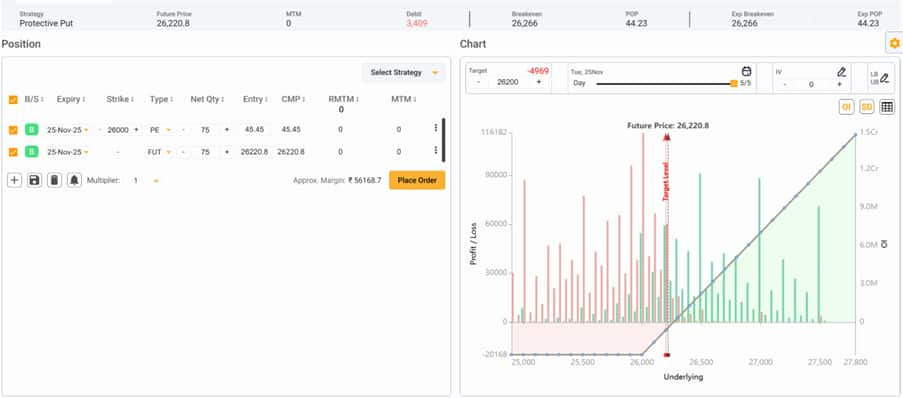Systematize equity investments with Options: Shubham Agarwal
Benefit of Systematizing the Investment with Options is that at times the returns earned out of the premium income would out do the profits made out of the core investments thanks to the very consistency it would deliver.
SHUBHAM AGARWAL | 14-Nov-20
Reading Time: 3 minutes

Options and Investments are the two words that seldom go hand in hand. Quite naturally Options of any kind would always find an enemy in time, while Equity Investments would always see time as a friend that has the capacity to improve on the possibility of the returns.
Now to find common ground we will have to give a twist to one of them. Since it is not feasible (although possible) from an Investment perspective, let us use options to create the opposite trade. So, if we sell options, both Investments and Options would be on the same side of time.
With this, we can revisit the concept of Equity Investments embedded with Options selling. As we all know when we buy an option, we have a right and when we sell an option we have an obligation to buy or to sell (depending upon the type of the option) a certain quantity of certain stock on a particular day at a particular price.
Now the obligation of buying or selling something may create a negative impact if we do not have the readiness to do so. By readiness, we mean both the willingness and ability to make good the obligation. Look at it this way, while we know an obligation of marriage would be impactful but something that is done with all willingness and ability to face it.
Similarly, let us just say we want to systematically keep Buying and at an interval selling some stock. A kind of stock, which we do not mind holding on to for the rest of our life. Here instead of just straight forward buying it, we would sell a Put of a lower strike price close to our desired price of entry.
If the stock goes below the strike price level and expires, we would be enforced with an obligation to buy the stock. This would not be negative for us as we already wanted to buy the stock at the strike price anyways.
The icing on the cake though is by selling Put, along with adding the stock into our portfolio at the desired price we also cashed in the Premium of the Put, which would eventually be discounted from the strike price, while accounting for the acquisition cost of the stock.
On the flip side, the lower price never got traded and the stock kept its price range above our desired price of the acquisition, nothing to worry about. The put premium pocketed will still be there to be cashed in. This is a reward for showing readiness for the obligation to buy.
Now let us assume that we could acquire the stock. The next step would be to keep the system running and to define that desired level of strike where we would not mind selling the stock. Once again, the readiness of obligation to sell can be cashed in by selling a Call option of the strike price closest to the desired selling price.
Similar to the Put in case if the acquired stock goes beyond the strike price level, the Sell position in Call will automatically push the stock out of the portfolio at a price equal to Strike Price + Premium of the Call. If the stock ends up lower than our desired selling price, we would pocket the premium for now and sell another Call in next expiry to sell the stock.
This process will keep on circling around in Sell Put, Buy Stock, Sell Call, Sell Stock sequence till we lose our faith on the stock in Buying any higher or Selling any lower.
Benefit of Systematizing the Investment with Options is that at times the returns earned out of the premium income would outdo the profits made out of the core investments thanks to the very consistency it would deliver.
(The author is CEO & Head of Research at Quantsapp)
Disclaimer: The views and investment tips expressed by investment experts on Moneycontrol.com are their own and not that of the website or its management. Moneycontrol.com advises users to check with certified experts before taking any investment decisions.
Learn and read more about implied volatility from Quantsapp classroom which has been curated for understanding of Nifty index from scratch, to enable option traders grasp the concepts practically and apply them in a data-driven trading approach.
Recent Articles

How to make profit when markets go sideways: Shubham Agarwal
20-Dec-25

Beyond Panic: Take control when your derivatives trade turns red, says Shubham Agarwal!
13-Dec-25

Evolve Your Trade: The missing step in most trading systems: Shubham Agarwal
06-Dec-25

Best trending option trading strategies: Shubham Agarwal
29-Nov-25

3 best ways to hedge using Options: Shubham Agarwal!
22-Nov-25

When in doubt to write, do Iron Fly: Shubham Agarwal!
15-Nov-25

Identify potential turning points with advance-decline: Shubham Agarwal
08-Nov-25

Slow and spreads more efficient: Shubham Agarwal
01-Nov-25

SHUBHAM AGARWAL is a CEO & Head of Research at Quantsapp Pvt. Ltd. He has been into many major kinds of market research and has been a programmer himself in Tens of programming languages. Earlier to the current position, Shubham has served for Motilal Oswal as Head of Quantitative, Technical & Derivatives Research and as a Technical Analyst at JM Financial.
Recent Articles

How to make profit when markets go sideways: Shubham Agarwal
20-Dec-25 12:14:00

Beyond Panic: Take control when your derivatives trade turns red, says Shubham Agarwal!
13-Dec-25 09:12:00

Evolve Your Trade: The missing step in most trading systems: Shubham Agarwal
06-Dec-25 20:43:00

Best trending option trading strategies: Shubham Agarwal
29-Nov-25 09:32:00

3 best ways to hedge using Options: Shubham Agarwal!
22-Nov-25 09:11:00

When in doubt to write, do Iron Fly: Shubham Agarwal!
15-Nov-25 10:48:00

Identify potential turning points with advance-decline: Shubham Agarwal
08-Nov-25 10:35:00











